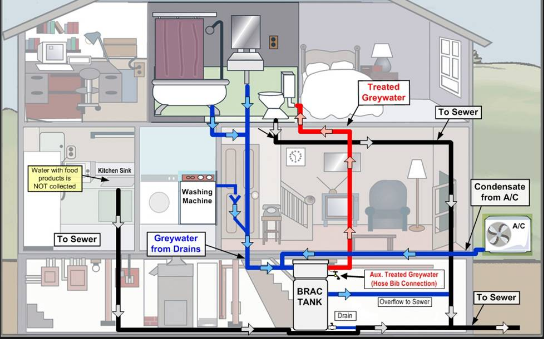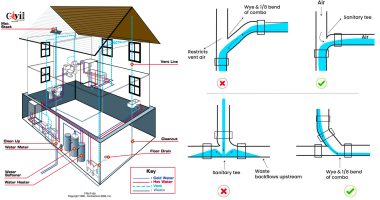A Closer Look at The Layout of Your House's Plumbing System
A Closer Look at The Layout of Your House's Plumbing System
Blog Article
The publisher is making a number of good pointers regarding Plumbing Installation 101: All You Need to Know overall in the article in the next paragraphs.

Understanding just how your home's plumbing system works is vital for each homeowner. From delivering clean water for alcohol consumption, food preparation, and showering to safely removing wastewater, a properly maintained plumbing system is important for your household's health and wellness and comfort. In this extensive overview, we'll discover the elaborate network that comprises your home's pipes and offer suggestions on upkeep, upgrades, and taking care of common issues.
Introduction
Your home's pipes system is greater than simply a network of pipes; it's a complex system that ensures you have accessibility to tidy water and effective wastewater elimination. Knowing its components and exactly how they interact can assist you protect against costly repair services and make certain everything runs efficiently.
Standard Components of a Pipes System
Pipelines and Tubes
At the heart of your pipes system are the pipes and tubing that carry water throughout your home. These can be made of different products such as copper, PVC, or PEX, each with its advantages in terms of sturdiness and cost-effectiveness.
Components: Sinks, Toilets, Showers, etc.
Components like sinks, toilets, showers, and bath tubs are where water is made use of in your home. Recognizing exactly how these components connect to the pipes system helps in detecting problems and planning upgrades.
Valves and Shut-off Points
Shutoffs manage the circulation of water in your pipes system. Shut-off shutoffs are crucial throughout emergency situations or when you require to make repairs, allowing you to isolate parts of the system without interrupting water circulation to the whole residence.
Water System
Main Water Line
The main water line attaches your home to the community water or an exclusive well. It's where water enters your home and is distributed to different fixtures.
Water Meter and Stress Regulator
The water meter procedures your water use, while a stress regulatory authority guarantees that water flows at a secure stress throughout your home's plumbing system, avoiding damage to pipes and components.
Cold Water vs. Hot Water Lines
Understanding the distinction between cold water lines, which provide water straight from the main, and warm water lines, which carry warmed water from the hot water heater, assists in troubleshooting and preparing for upgrades.
Drain System
Drain Water Lines and Traps
Drain pipes bring wastewater away from sinks, showers, and commodes to the sewage system or sewage-disposal tank. Catches avoid sewer gases from entering your home and also trap debris that can trigger obstructions.
Air flow Pipes
Ventilation pipes permit air into the drain system, preventing suction that might reduce drainage and trigger catches to vacant. Proper ventilation is crucial for maintaining the stability of your pipes system.
Importance of Correct Drain
Ensuring correct water drainage avoids back-ups and water damage. On a regular basis cleansing drains pipes and maintaining traps can stop costly repairs and extend the life of your pipes system.
Water Furnace
Kinds Of Hot Water Heater
Hot water heater can be tankless or traditional tank-style. Tankless heating units warm water as needed, while tanks store heated water for instant usage.
Just How Water Heaters Connect to the Plumbing System
Comprehending exactly how hot water heater link to both the cold water supply and hot water distribution lines helps in identifying problems like not enough warm water or leakages.
Upkeep Tips for Water Heaters
Frequently flushing your hot water heater to eliminate debris, inspecting the temperature level setups, and checking for leakages can prolong its life-span and boost power performance.
Usual Pipes Concerns
Leaks and Their Causes
Leakages can occur due to aging pipes, loose installations, or high water stress. Attending to leaks immediately stops water damage and mold growth.
Blockages and Clogs
Obstructions in drains pipes and bathrooms are commonly triggered by purging non-flushable products or a buildup of oil and hair. Utilizing drain screens and being mindful of what decreases your drains can protect against blockages.
Indications of Plumbing Issues to Watch For
Low tide stress, sluggish drains, foul odors, or unusually high water expenses are signs of potential pipes issues that ought to be dealt with without delay.
Plumbing Upkeep Tips
Routine Inspections and Checks
Arrange annual pipes examinations to capture issues early. Try to find indications of leaks, deterioration, or mineral accumulation in faucets and showerheads.
Do It Yourself Upkeep Tasks
Easy jobs like cleaning tap aerators, looking for commode leaks using color tablet computers, or insulating revealed pipelines in cold environments can stop major plumbing concerns.
When to Call a Specialist Plumbing Technician
Know when a pipes problem requires specialist expertise. Trying complicated repair services without appropriate knowledge can cause more damage and higher repair work prices.
Upgrading Your Plumbing System
Reasons for Updating
Upgrading to water-efficient fixtures or replacing old pipelines can improve water quality, decrease water expenses, and enhance the value of your home.
Modern Pipes Technologies and Their Advantages
Discover technologies like wise leak detectors, water-saving bathrooms, and energy-efficient water heaters that can conserve cash and lower ecological influence.
Price Considerations and ROI
Determine the upfront costs versus lasting financial savings when thinking about pipes upgrades. Lots of upgrades spend for themselves with decreased utility expenses and less fixings.
Environmental Impact and Conservation
Water-Saving Components and Home Appliances
Mounting low-flow faucets, showerheads, and toilets can significantly minimize water usage without giving up efficiency.
Tips for Minimizing Water Use
Basic behaviors like repairing leaks without delay, taking shorter showers, and running complete lots of washing and recipes can conserve water and lower your energy expenses.
Eco-Friendly Plumbing Options
Consider sustainable pipes materials like bamboo for flooring, which is durable and green, or recycled glass for kitchen counters.
Emergency situation Preparedness
Actions to Take Throughout a Pipes Emergency
Know where your shut-off valves lie and just how to switch off the water system in case of a ruptured pipeline or major leakage.
Importance of Having Emergency Situation Get In Touches With Convenient
Keep get in touch with details for local plumbers or emergency services conveniently available for quick action throughout a plumbing situation.
DIY Emergency Fixes (When Appropriate).
Short-term solutions like utilizing duct tape to spot a dripping pipe or positioning a pail under a dripping faucet can reduce damages until a specialist plumber gets here.
Final thought.
Understanding the makeup of your home's pipes system encourages you to maintain it properly, saving money and time on repairs. By following regular maintenance regimens and staying informed about modern pipes innovations, you can guarantee your pipes system runs effectively for many years to find.
HOW YOUR PLUMBING SYSTEM WORKS
Which Pipes Do What?
Blue lines = fresh water supply entering the building
Red lines = hot water supply entering the building
Grey lines = pipes carrying waste away from the building and venting pipes carrying gases away from the building (through the roof)
YOUR MAIN PLUMBING SYSTEMS
There are two main plumbing systems that support your home s basic plumbing needs one that brings clean water into your home, and one that sends dirty water away from your home. Connected to the toilet, bath, shower, and other faucets in your home, these two systems keep your water flowing in the right directions.
ACCESSING FRESH WATER
Fresh and clean water is brought into your home through the main water supply line . Filtered through one pipe, this water is pressured to flow into the various fixtures in your home at any given time.
This water can be sourced from a well located on your property, a pond or river (mostly cottages), or, as in most cases, from the city s municipal water treatment centre. However, it is important to note that water that is untreated, such as the water siphoned from ponds or rivers, may not be safe to drink. Personal water supplies always need to be treated for hardness and contaminants before consumed.
MUNICIPAL WATER SUPPLIES
Improve taste and odour
Remove sediment
Eliminate hardness
Reduce chlorine
COLD WATER SUPPLY VS. HOT WATER SUPPLY
Cold water flows into your home or building through the service line, which then distributes hot or cold water to your fixtures. This line is most commonly run through a central column that runs floor to floor. Hot water runs in short and straight pipes as the longer the pipeline, the more heat that will be lost in the transfer. Having shorter pipes also allows residents to access hot water more quickly.
WASTE WATER SYSTEM
Your wastewater system is divided into two parts pipes that send wastewater away from your home and venting pipes that send sewer gas away from your home. Sewage water travels through pipes that flush the water and waste towards local sewers that are operated and managed by your city or town. Most sewer systems rely on gravity to move the wastewater to where it needs to go.
The further away from your toilet or sink, the larger wastewater pipes become. This allows for waste to be disposed of from various parts of your home or business at once without pipe blockages. The angle and flow of these pipes are also essential for keeping your waste pipes clear of build up.
https://harrisplumbing.ca/how-your-home-plumbing-system-works/

HOW YOUR PLUMBING SYSTEM WORKS
Which Pipes Do What?
YOUR MAIN PLUMBING SYSTEMS
There are two main plumbing systems that support your home s basic plumbing needs one that brings clean water into your home, and one that sends dirty water away from your home. Connected to the toilet, bath, shower, and other faucets in your home, these two systems keep your water flowing in the right directions.
ACCESSING FRESH WATER
Fresh and clean water is brought into your home through the main water supply line . Filtered through one pipe, this water is pressured to flow into the various fixtures in your home at any given time.
This water can be sourced from a well located on your property, a pond or river (mostly cottages), or, as in most cases, from the city s municipal water treatment centre. However, it is important to note that water that is untreated, such as the water siphoned from ponds or rivers, may not be safe to drink. Personal water supplies always need to be treated for hardness and contaminants before consumed.
MUNICIPAL WATER SUPPLIES
COLD WATER SUPPLY VS. HOT WATER SUPPLY
Cold water flows into your home or building through the service line, which then distributes hot or cold water to your fixtures. This line is most commonly run through a central column that runs floor to floor. Hot water runs in short and straight pipes as the longer the pipeline, the more heat that will be lost in the transfer. Having shorter pipes also allows residents to access hot water more quickly.
WASTE WATER SYSTEM
Your wastewater system is divided into two parts pipes that send wastewater away from your home and venting pipes that send sewer gas away from your home. Sewage water travels through pipes that flush the water and waste towards local sewers that are operated and managed by your city or town. Most sewer systems rely on gravity to move the wastewater to where it needs to go.
The further away from your toilet or sink, the larger wastewater pipes become. This allows for waste to be disposed of from various parts of your home or business at once without pipe blockages. The angle and flow of these pipes are also essential for keeping your waste pipes clear of build up.
https://harrisplumbing.ca/how-your-home-plumbing-system-works/
We had been made aware of that report on The Inner Workings of Your Home's Plumbing through an acquaintance on a different web blog. Kindly take the time to promote this blog if you appreciated it. Thank you for your time invested reading it.
Article Report this page